Don’t have time for long reviews of comics? Then check out Graphic Bits: bite sized chunks of comic book goodness designed to get behind the panels and into your hearts.
It’s a week (9 July 2014) of debuts from the three top dogs in the funny book business. Nightwing gets the cold winter shoulder in Grayson #1 (DC Comics), while the Suicide Squad reform in…erm…New Suicide Squad #1 (DC Comics). Marvel continues its time-travel fiascos in Spider-Man 2099 #1 (Marvel). The the apocalypse gets bitey again in Spread #1 (Image).
Grayson #1
DC Comics, Tim Seely, Tom King (writers), Mikel Janin, Jeromy Cox
Rating: 7.5/10
 Dick Grayson is one of the few major DC characters that not only grew and morphed over the years, but retained much of his pre-Flashpoint progression. He’s graduated from Robin, to an estranged partner to Batman and eventually leading a solo life as the leader of the the Teen Titans, New Teen Titans and the Outsiders as both Robin and his alter-ego Nightwing. He even took over the mantle of Batman during his absence. With the events of Forever Evil behind us, Dick Grayson is outed to the world as Nightwing. So what does one of the most televised images during a global war do? Become a secret agent. Naturally.
Dick Grayson is one of the few major DC characters that not only grew and morphed over the years, but retained much of his pre-Flashpoint progression. He’s graduated from Robin, to an estranged partner to Batman and eventually leading a solo life as the leader of the the Teen Titans, New Teen Titans and the Outsiders as both Robin and his alter-ego Nightwing. He even took over the mantle of Batman during his absence. With the events of Forever Evil behind us, Dick Grayson is outed to the world as Nightwing. So what does one of the most televised images during a global war do? Become a secret agent. Naturally.
Seemingly taking a leaf out of The Winter Soldier’s success, Seely and King begin their story in media res, throwing readers in at the deep end. If Dick’s decision to join Spyral, the former Batwoman’s secret spy organisation, was made in another comic, it is not immediately obvious to new readers. As such, there is a certain amount of time spent finding one’s feet with this issue, especially when Helena Bertinelli (Huntress) turns up as a fellow agent, although the writers give us very little time to pause for this kind of thought in this high-octane debut.
Artist Janin makes full use of Grayson’s acrobatic abilities, especially during a killer James Bond-style opening sequence aboard a train, and a novel use of a gun and a telegraph pole. Jeremy Cox’s colours are a light-hearted affair, something that may jar with Nightwing aficionados, immediately differentiating it from the former chapter of Dick Grayson’s life.
Bottom Line: Grayson is a promising new direction for one of DC’s oldest characters. It’s the kind of changes that make their way organically into a long-running comic book, ones that can only happen once some history is behind them. It’s a dichotomy that sits outside the New 52, but wholly encapsulates the best bits of it as well. Dick Grayson: Super Spy? It just might work.
New Suicide Squad #1
DC Comics, Sean Ryan (writer), Jeremy Roberts, Blond (art)
Rating: 7/10
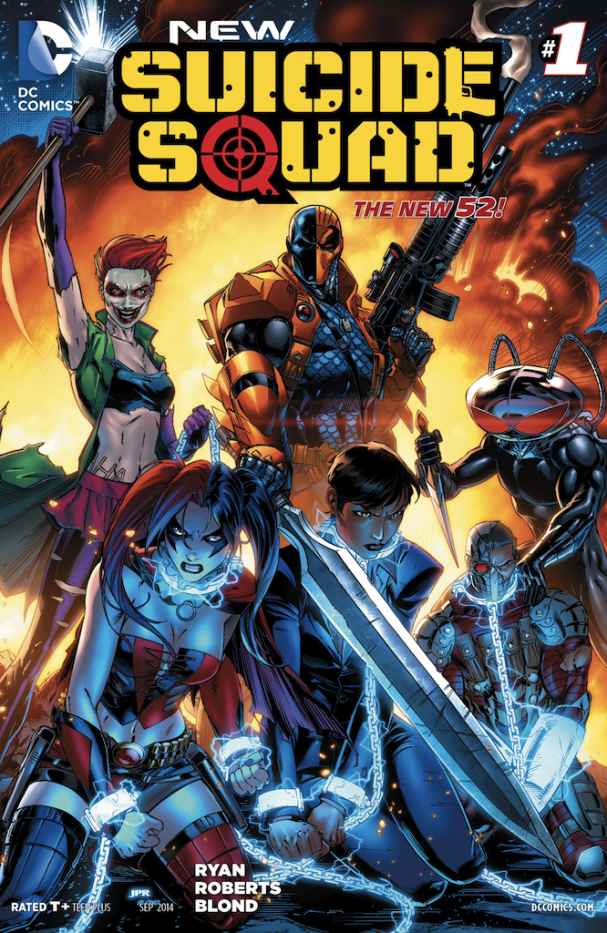 The Suicide Squad have been shot into the limelight again lately, thanks in part to their introduction to the second season of TV’s Arrow. Indeed, it is difficult to walk into any comic convention and not see dozens of Deathstrokes and Harley Quinns, so it would be madness for DC to not capitalise on the fame of these characters. Yet the title wasn’t cracking the Top 100 towards the end of its first New 52 run, and thus the New Suicide Squad was born in its wake. Is it enough to save this flagging title?
The Suicide Squad have been shot into the limelight again lately, thanks in part to their introduction to the second season of TV’s Arrow. Indeed, it is difficult to walk into any comic convention and not see dozens of Deathstrokes and Harley Quinns, so it would be madness for DC to not capitalise on the fame of these characters. Yet the title wasn’t cracking the Top 100 towards the end of its first New 52 run, and thus the New Suicide Squad was born in its wake. Is it enough to save this flagging title?
New Suicide Squad wears its corporate groupthink on its sleeve, even introducing Sage, a slick bureaucrat who insists that “This team should look like the best group of bad people ever put together”. The bigger, faster, slicker Suicide Squad (or Task Force XL as Sage wants to dub them) is all about looks, and that goes for the book itself. It’s fanservice from the get-go, and artist Roberts completely nails a sequence of Harley Quinn casually lobbing a grenade into a building with a baseball bat. Yet it is also fairly surface level, with the Joker’s Daughter sandwiched in (because she needed to go somewhere, we guess) and by the title’s own admission, Black Manta is included because he has “a cool look. Plus he’s got the word black in his name. That never hurts.”
Bottom Line: If you are looking for a book that has got all the delightfully bad characters you love simply blowing things up, then New Suicide Squad just might be the title for you. Setting up future rivalries signals some interesting potential storylines, but for now it remains a solid piece of brain candy.
Spider-Man 2099 #1
Marvel, Peter David (writer), Will Sliney (artist)
Rating: 8/10
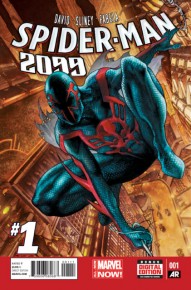 One of the more successfully wacky threads (of many wacky threads) that came out of the pages of Dan Slott’s Superior Spider-Man, and subsequent Amazing Spider-Man, was the arrival of Miguel O’Hara in the present day Marvel universe. Rather than being another cheap Marvel time travel gimmick (ok, it is a little bit, but we’ll forgive it this 700th time), it has very real consequences and signals things to come in November’s Spider-verse amongst other things.
One of the more successfully wacky threads (of many wacky threads) that came out of the pages of Dan Slott’s Superior Spider-Man, and subsequent Amazing Spider-Man, was the arrival of Miguel O’Hara in the present day Marvel universe. Rather than being another cheap Marvel time travel gimmick (ok, it is a little bit, but we’ll forgive it this 700th time), it has very real consequences and signals things to come in November’s Spider-verse amongst other things.
While die-hard fans of the original Marvel 2099 line may be disappointed to not see their favourite futuristic webslinger in native New York of the future, character co-creator Peter David returns to ensure some consistency with the character in a contemporary context. Stranded in the first half of the 21st century, he is determined to steer his grandfather’s company in the right direction so that it doesn’t become a menace in the future. Despite folks remarking that Miguel lacks Peter Parker’s trademark jokes, the book has a decent amount of humour, not least of which is ‘Miggy’ leasing a flat that still has bloodstains from the previous tenant on the floor. Yet Miguel has very little time to settle when an adjustor from T.O.T.E.M. (Temporal Oversight Team Eliminating Mistakes) arrives to “destroy” him at correct future timelines.
Will Sliney’s artwork is, at times, sublime. He perfectly captures the graceful acrobatics of the character, especially our first shot of “S-Man” in full costume arching his way over New York. For the most part, it’s typical blockbuster stuff, focusing on close-ups and minimal background details, yet it perfectly suits the material and tone of the book.
Bottom Line: It’s the Spider book we didn’t know we needed! It may all fall apart after a few issues, especially as New York comes to term with multiple Spider-Men, but for now this is fun way to reintroduce a fan-favourite into the main Marvel line.
Spread #1
Image Comics, Justin Jordan (writer), Kyle Strahm (artist)
Rating: 8.5/10
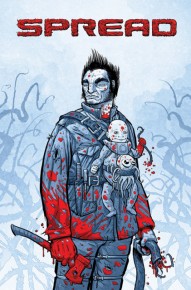 Writer Justin Jordan notes in the backmatter of the first issue of Spread that what fascinates him is “what the world would look like ten or twenty years after” the zombie apocalypse. Which is where this title more or less begins, with ten years having passed since humankind dug “too deep” and unleashed something that couldn’t be controlled: The Spread. In this harsh landscape, the Wolverine-esque axe-wielding ‘No’ is immune to the Spread’s twisted and bitey virus. His fate changes when he rescues a baby that might just hold the cure to the disease itself.
Writer Justin Jordan notes in the backmatter of the first issue of Spread that what fascinates him is “what the world would look like ten or twenty years after” the zombie apocalypse. Which is where this title more or less begins, with ten years having passed since humankind dug “too deep” and unleashed something that couldn’t be controlled: The Spread. In this harsh landscape, the Wolverine-esque axe-wielding ‘No’ is immune to the Spread’s twisted and bitey virus. His fate changes when he rescues a baby that might just hold the cure to the disease itself.
There is a certain sense of the familiar to Spread, sitting somewhere between the video game The Last of Us and Image’s own Saga (in that a grown-up baby is narrating the fate of its ‘parents’), yet this might only be due to Jordan’s apparent familiar with the genre. Having already given us The Strange Talent of Luthor Strode and the darkness of Dead Body Road, he takes the tropes of the road weary apocalyptic genre and throws a badass into it, so that it’s less Walking Dead and more Mad Max.
Strahm’s (We Will Bury You) striking art is something else, somewhat reminiscent of Sean Murphy in the immediacy to the rough edges. It’s a harsh art style for a harsh environment, and it’s difficult to imagine a more perfect fit. Creating a landscape that would be a reality if John Carpenter’s The Thing had been left unchecked. The twisted, gnarling Spread is a sharp red contrast against the snow-capped scenery, all eyes filled with teeth and phallic tentacles blobbing their way over everything. Now imagine that coming out of someone’s face, and you’re halfway to the horrors that Strahm has in store for you.
Bottom Line: Spread makes a welcome addition to the horror genre, introducing a badass new hero with a clear goal and end-point. It’s a title that could have a long run ahead of it if it maintains this quality and same level of nail-biting cliffhangers for its duration. Come for the story, stay for Strahm’s next level art.
Agree or disagree? Got a comment? Start a conversation below, or take it with you on Behind the Panel’s Facebook and Twitter!
If you are an iTunes user, subscribe to our weekly podcast free here and please leave us feedback. That’s how we get more attention! Go do it now. We’ll be waiting right here.

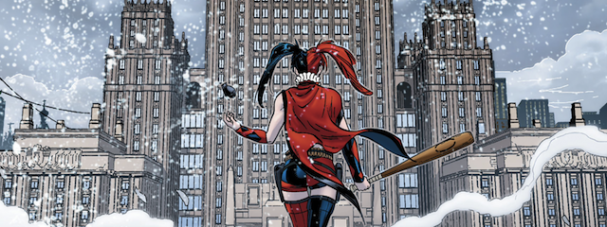
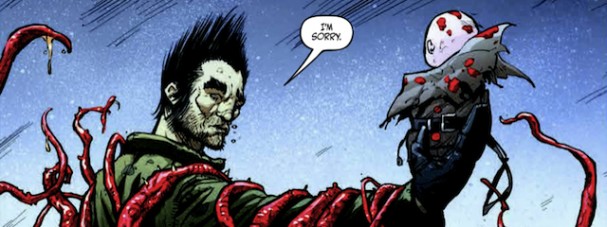

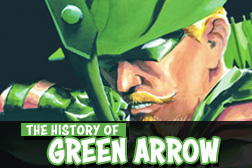

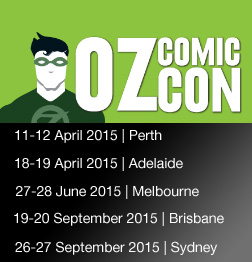





1 pings
[…] is used to. What’s interesting about this original clean solicitation version is that it differs from the final version, where they changed Dick’s hair. The other cover is a 75th anniversary of Batman variant, […]